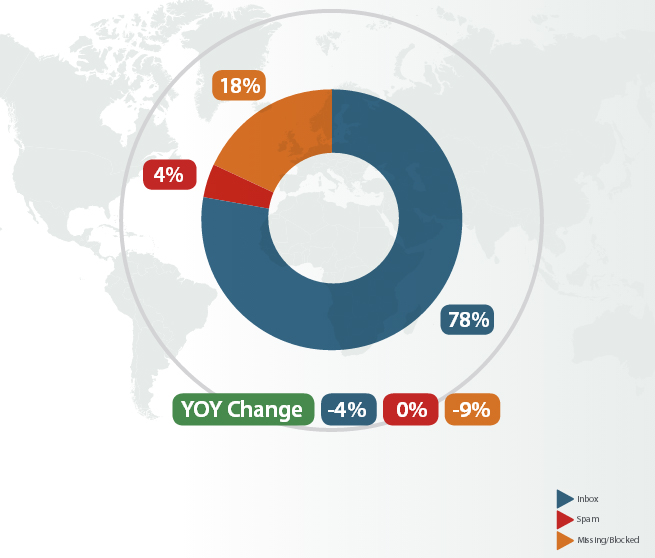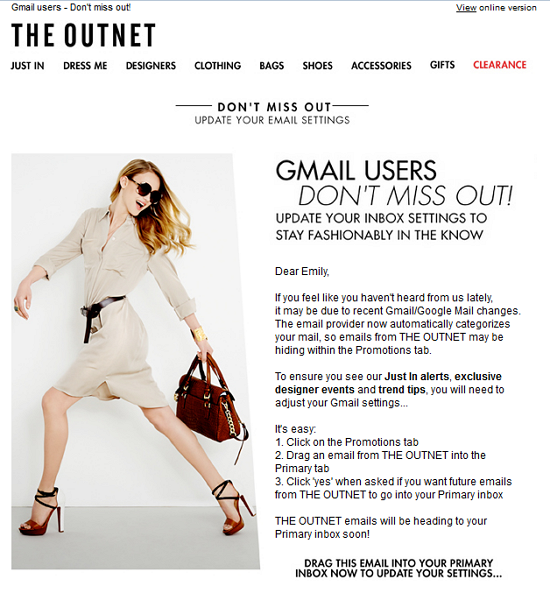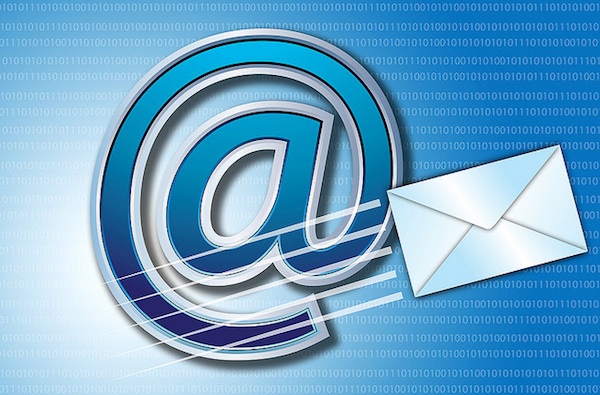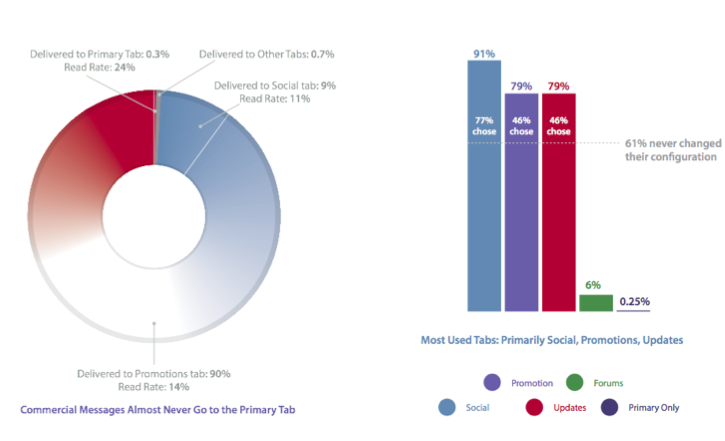According to ReturnPath’s 2013 email benchmark survey – 22% of opt-in emails aren’t reaching subscribers’ inboxes. And while that number is down from the 28% of the previous year – it still demonstrates that nearly a quarter of messages are missing the mark.

Email deliverability is improving, but only slightly
Despite advances in email marketing technology, spam trapping and opt-in communications, improving these numbers for yourself (essentially, your email reputation) is fairly simple and fundamental. Still, it’s all too easy to forget (or outright ignore) the basics.
First, let’s take a look at how emails are filtered. Understanding this will give you an inside look at reasons why your message could go missing.
Email Filters
Many email programs use simple filters to sort messages before they ever land in your inbox. You’ve likely set some of these up yourself – mail from domain “fakerolexwatchexample.com†automatically gets shuttled to the circular file, for example.
But your internet provider also tries to lend a hand in filtering. Oftentimes, ISPs will subscribe to a number of spam-detecting and filtering services, which in turn helps to free up their bandwidth and keeps junk traffic from bottlenecking in their networks. These services rely on domains and URLs being noted as spam by their subscribers, and thus blacklisted.
False-Positive Spam
Sometimes, your email address can be falsely marked as spam – particularly if your email message contains certain spam trigger words that have the unfortunate side effect of blacklisting your message before it ever goes through.
Here are few common trigger words:
- Buy
- Buy direct
- Order
- Cheap
- Cash
- $$$
- F r e e
- Save up to
- Success
- Wife
- Medium
- Avoid
- Friend
- Hello
- Dear
For a long list of spam trigger words, take a look at this Hubspot article.
Gmail’s Tabbed Inbox
Gmail’s newly-released tabbed inbox is in a class all its own when it comes to message filtering. Essentially, Gmail has taken it upon itself to automatically sort your messages into convenient “buckets†— Primary messages are from people you know and trust – friends, family and colleagues. Social messages are notifications from your social networks, and promotions are emails such as coupons, deals and offers (even if you’ve already subscribed to and whitelisted them).

Gmail’s introduction to the tabbed inbox
What’s more, a sponsored ad can appear at the top of your inbox and look precisely like a message sent on behalf of Google to clue you in to something you might like. It has its own sender, description and subject line – just like an actual email would.

A clever example of a Gmail ad
Currently, Gmail ads only appear in the promotional tab, so it’s in Google’s best interest to encourage users to click there. Fortunately, users are quickly learning that if they want access to the email deals they opted in to receive, they’d better pay attention to the Promotions tab.
A study by Returnpath has already been done to determine the deliverability and read rates of messages that are sent to the different tabs:
90% of commercial messages go to the Promotions tab – by the Primary tab is by far the most read
How to Gain Entry to the Ultra-Exclusive Primary Tab
The primary tab is where the biggest chunk of the reading takes place – and marketers are keen to get their emails into this ultra-exclusive favorites club. Here’s one tactic that a fashion site is using by sending out an email blast specifically targeting Gmail users:

When you drag an email into the primary inbox, you automatically whitelist the sender so that future messages from them will also be put in the Primary tab. Therefore, it’s in every marketer’s best interest to give their subscribers instruction on how to perform this one-time drag-and-drop.
Trigger Words that Get You in the Inbox
Just like trigger words can get your email mistakenly labeled as spam, so too can trigger words increase your odds of landing on the primary tab or inbox. In the case of Gmail, certain trigger words can also automatically land you in the Promotions tab – words like coupon, alert, direct message and receipt. Which words were most likely to make it past the digital gatekeeper?
Financial-sounding words like statement, reply and attachment. SMS led the pack though, with a staggering 51% of messages featuring it as part of the subject line getting a free pass:

Financial terms like statement and attachment get priority over other terms
What Email Marketers Need to Know
The bottom line is that, as senders, we need to keep our pulse on the kind of content our readers like and appreciate. The more our messages are tailored to their needs, the more likely they are to give us that coveted whitelisting.
With that being said, however, consumers will still mark a message as spam even if they originally opted in to receive it. For many users, marking a message as spam doesn’t so much say “I don’t know who this sender isâ€, but “this offer doesn’t fit me.†ReturnPath’s survey also found that subscribers were more likely to tag an email as spam rather than unsubscribe (even if the unsubscribe link was noticeable).
Beyond those things, here are a few more best practices to keep in mind:
- Make sure your list is spotlessly clean. No purchased email lists, no matter how fresh they promise to be. Survey your list and segment users accordingly to keep them in the loop with helpful messages that they’ll be more likely to read, click and interact with.
- On that note, many email providers will gauge how “whitelistable†you are as a sender, based on how the user interacts with your message. If they hit Delete as soon as it loads, your sender score will drop, whereas if they reply, forward, scroll or click, your score will increase.
- If you’ve been falsely blacklisted, it’s a good idea to set up a monitored email address – such as abuse@yourdomain.com so that spam-filtering organizations and major ISPs can report this abuse to you. Keep your list informed of the steps you’re taking to fight these fake and false subscribers.
- Your email marketing provider should allow you to track who has opened your messages. If the same subscriber hasn’t opened your mailings two times, try sending them a personal note and ask if they’d like to receive messages with less frequency, or what you can do to connect with them in a way they’d appreciate?
- If your subscriber still doesn’t open your message a third time, remove them from your list. The same rule applies if an email bounces back (although most modern email services will remove it automatically if this happens)
View the Infographic: The Rise of Mobile and Triggered Emails
About the Author: Sherice Jacob helps business owners improve website design and increase conversion rates through compelling copywriting, user-friendly design and smart analytics analysis. Learn more at iElectrify.com and download your free web copy tune-up and conversion checklist today!
 Only a couple of years ago, pundits were predicting an end to email. But instead of fading away, there’s been ever-increasing email volume and usage. Rather than being replaced by Facebook and Twitter streams, email is actually becoming a stream itself.
Only a couple of years ago, pundits were predicting an end to email. But instead of fading away, there’s been ever-increasing email volume and usage. Rather than being replaced by Facebook and Twitter streams, email is actually becoming a stream itself.
Mail systems are evolving to match the new volume of email, and users will increasingly see only algorithmically vetted emails. Some other emails may be shown below the vetted email, and the rest will flow away into temporal oblivion, just like uninteresting social posts from a few hours ago.
Implications for marketers are significant. The days of the average AOL or Yahoo! mail user scrolling through every email in their inbox are rapidly fading. Email has been especially important in e-commerce sales and customer re-engagement. For e-commerce in particular, email marketing exceeds the performance of social advertising. Large-volume email senders will need to make a greater effort to send emails that are both personalized and interesting to the recipient.
The email tsunami problem is pervasive. Several Silicon Valley folks have already committed the unfortunately termed “email suicide,†where they give up on reading unread email and start anew. Others are adding email auto-responders stating that they will not necessarily see email. New vendors such as SendGrid have helped bring on the deluge by dramatically lowering the price of sending volume email and democratizing access with simplified onboarding and easy developer APIs.
Google has added several features to Gmail in an attempt to add some order to the chaos of email. The changes will effect both email users and marketers. With Gmail features like Priority Inbox, Gmail Tabs, and Circles, users are increasingly engaging only with algorithmically vetted email from senders they know. Priority Inbox is only a satisfactory product and needs to evolve to automatically mark as “important†email from senders that a recipient repeatedly opens, especially if the recipient replies. Next-generation email clients like Inky go as far as sorting email by relevance rather than date.
 For marketers, sending a ton of email without any user engagement will soon become counterproductive. For each type of volume sender, a new balance will have to be found between sending numerous emails and still achieving desired “open rates†and “clickthroughs†— mechanisms by which an email provider like Google can detect whether or not the email is of interest to a user. Much like how “edge rank†increases for Facebook posts when the people like, share or comment on it, “mail rank†will be an increasingly important benchmark for email marketers to measure their effectiveness.
For marketers, sending a ton of email without any user engagement will soon become counterproductive. For each type of volume sender, a new balance will have to be found between sending numerous emails and still achieving desired “open rates†and “clickthroughs†— mechanisms by which an email provider like Google can detect whether or not the email is of interest to a user. Much like how “edge rank†increases for Facebook posts when the people like, share or comment on it, “mail rank†will be an increasingly important benchmark for email marketers to measure their effectiveness.
At CBS Interactive, we send over 200 million emails a month, ranging from news summaries to personalized fantasy sports updates, to an audience of 270 million unique users. We have corporate standards and systems to ensure that recipients can easily unsubscribe from unwanted emails. However, given these upcoming changes, we will need to look at overall open rates from a particular property and begin to proactively prune users that have no interest in emails we send.
 The shift to email as a stream will have personal implications as well. People may have to be introduced via a mutual party rather than sending a cold email, especially if the sender has sent numerous emails that have not entailed or received a response. Even personal emails from people you know may soon be treated like a Facebook or Twitter post, where a user either immediately responds, such as with a Facebook like or comment, or instead lets it flow into the ether. Much like social posts, senders will likely shift toward keeping email messages short and to the point.
The shift to email as a stream will have personal implications as well. People may have to be introduced via a mutual party rather than sending a cold email, especially if the sender has sent numerous emails that have not entailed or received a response. Even personal emails from people you know may soon be treated like a Facebook or Twitter post, where a user either immediately responds, such as with a Facebook like or comment, or instead lets it flow into the ether. Much like social posts, senders will likely shift toward keeping email messages short and to the point.
Facebook and Twitter both have nascent but unique takes on messaging. Facebook messages that are not from one of your friends go into an “other†folder that is rarely read. Twitter direct messages can only be sent to people who follow the sender, although Twitter is experimenting with opening this up a bit.
Stream-oriented companies like Facebook and Twitter essentially charge brands to target their own customers by allowing brands to purchase promoted posts for their fans and followers. Email providers may soon sell “promoted emails†where a marketer can target a user in their priority inbox. Users may revolt, but in the end they are getting email for free, so it will be hard to complain. Email has become a stream, and as the adage goes, when you’re not paying, you’re the product.
 Peter Yared is the CTO/CIO at CBS Interactive. Follow him on Twitter @peteryared.
[Image: Shutterstock]
 Drip marketing is a term to describe a series of autoresponder emails that are sent out in a specified time interval to customers who opt into your website.
Drip marketing is a term to describe a series of autoresponder emails that are sent out in a specified time interval to customers who opt into your website.
This is a fairly common practice. The email may be to welcome you, to educate you about products, or to offer you discounts, but the goal is to convert prospects to customers and customers to repeat customers.
I’m writing this from Disney World. This is my first time coming here, and I was a bit taken aback that I have to walk my kids through a gift shop every time that they eat or take part in an event at the resort or at the parks.
Essentially this is the goal of your drip marketing campaign, since your opt-in customers visit their email regularly you are setting up a gift shop (of sorts) through your email.
Just as Disney has optimized their merchandising to make sure my daughter sees princesses and my son sees monsters each time they pass through, you must maximize the effectiveness of your drip marketing campaigns to better convert these customers.
In this post I’m going to showcase four case studies, showing how some businesses have optimized their drip marketing campaigns, how they decide on frequency, decide on content, and how one company creatively segmented their opt-ins to generate a lot of business.
1. Dynamic Search gets a double-digit increase in click-through
Search agency Dynamic Search implemented an eleven episode drip campaign over the course of the nine months after opt-in. Principal Asher Elram admits to not being a huge believer in email marketing prior to implementation, but by executing their drip campaign click-through has increased between 12 and 18%. Results like that will quickly restore your faith in email as a marketing tactic.
Eleven emails isn’t a random number. You can be sure that Dynamic Search A/B tested their frequency and timing quite thoroughly. However, before testing timing marketing expert Tommy Walker recommends A/B testing subjects lines. This makes intuitive sense: it’s important that Disney gets its princesses and monsters at a three-year old eye level before trying to decide the best times to do anything else.
The recommendation to A/B test should be extended to all content and its parameters. Email is ideal because you can isolate test groups and customer segments to get a good data about what works and what doesn’t.
2. Studentbeans mixes dynamic content with static to increase revenue 13%
UK website studentbeans.com offers deals and advice for college students. They get a lot of web traffic (to the tune of six million visits a year) but were having trouble converting that traffic into click-through and sales.
What they decided to do was to introduce dynamic content into their static drip campaign, for example augmenting their prescribed content with a current offer, discount or deal. The results were extraordinary: open rates increased 66% and revenue increased 13%.
3. Iron Tribe Fitness qualifies and converts 50% of online prospects
One key to drip campaigns is to create high-value content.
Iron Tribe Fitness is a high-end fitness gym. It’s not like the gym most people go to – users have to commit quite a bit of time and resource (an average user spends $2000 during their time with ITF). Before implementing a drip campaign to their marketing, most members were acquired offline.
ITF implemented a drip campaign which sent opt-in prospects eleven emails in eighteen days. These emails educated the prospects about ITF and qualified them as proper prospects for their niche (high-end) product.
The result? About half of opt-in prospects became members (to the tune of $2000 revenue each). Did I mention that Iron Tribe Fitness is a franchise?
Similarly, the Moz.com website uses an autoresponse campaign to teach new users how to use their tools. While this may sound somewhat mundane, these educational emails actually drove a million dollars in revenue in four months by retaining new users.
Smileycookie segments to increase sales 29%
Cookie selling website smileycookie.com noted a significant problem with cart abandonment. They implemented a drip campaign specific to users who abandoned their cart (note that they had to add some controls on their site to capture emails in advance of users leaving cookies in their virtual carts).
Their campaign had three parts: an immediate email, a second email twenty-three hours later offering a discount and a third email four days later offering an even larger discount. The results? The open rate of the first two emails is greater than 50% (usual open rate is 20%). CTR for email one is 28%, two is 16% and three is 6%, meaning that more than a quarter of people who abandoned their cart went back to the site afterwards.
Not a lot of businesses have the scale or customer-affinity that Disney has. Just as I’m going to walk through a dozen gift shops today with my kids picking up random items before being thwarted by my “no†(which is sometimes thwarted by my wife’s “yesâ€), your customers have given you the opportunity to educate them, to offer them discounts, and to convert them by giving you their email address.
Drip campaigns are a low-cost way to do this, provided you do it thoughtfully.
Jim Dougherty is an expert on social media and technology who blogs at Leaders West. For more marketing advice from Jim, click here.
E-Mail Beats Facebook And Twitter For Driving Purchases, Especially Amongst High Earners [Study]
Tags:
 A new study has revealed that email continues to prove itself as the marketing method of choice for driving online purchases from websites, particularly if your target demographic includes high earners.
A new study has revealed that email continues to prove itself as the marketing method of choice for driving online purchases from websites, particularly if your target demographic includes high earners.
AW Pro Tools surveyed 1,500 consumers nationwide about which activities lead to most of their online spending, and made two interesting discoveries. First, that the vast majority (67.3 percent) aren’t influenced by any of the major digital marketing channels whatsoever. But, second, those that are are mostly influenced by email – particularly if they’re wealthy.
One-third of respondents across all incomes were influenced by digital marketing tools when making online purchases, with email (13.8 percent) and Facebook (13.5 percent) leading the way, far ahead of Twitter, which registered with less than two percent of respondents.
![Email Beats Facebook And Twitter For Driving Purchases, Especially Amongst High Earners [STUDY]](http://www.mediabistro.com/alltwitter/files/2013/10/awprotools-online-shopping-three.png)
For online shoppers who earned $100,000 or more, one-third were influenced by email, which finished significantly ahead of second-placed YouTube (5.6 percent). Both Facebook and Twitter returned big, fat zeroes.
“There’s no doubt that Facebook, YouTube, and even Twitter offer exciting advertising opportunities,†says Jack Born, CEO of AW Pro Tools. “But the winning strategy for entrepreneurs and Fortune 500 companies alike is to attract a base of raving fans that open, read, and click on the emails you send. Without a well thought out email strategy, money spent on any advertising is going to be much less effective. Especially if you want to attract high income clients.â€
By Shea Bennett
Â
(Source: AW Pro Tools.)
CALENDAR
CATEGORIES
TAGS
TWITTER POSTS
CALENDAR
- powered by
- One Big Broadcast
- creative by
- WebStager
© 2025 One Big Broadcast | All rights reserved




![Email Beats Facebook And Twitter For Driving Purchases, Especially Amongst High Earners [STUDY]](http://www.mediabistro.com/alltwitter/files/2013/10/awprotools-online-shopping-two.png)